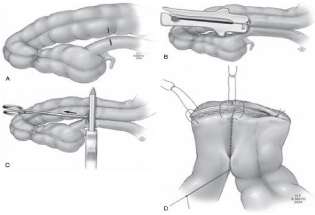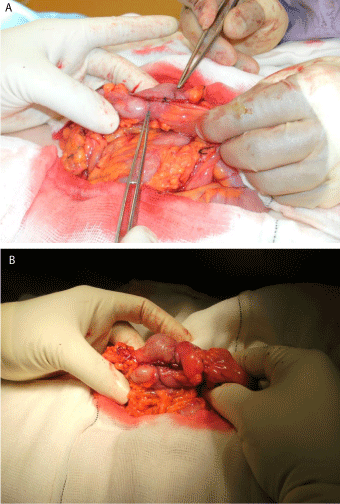Surgical Technique
Stapled Bowel Anastomosis: A Technical Tip
Sanjay Harrison1, Srinivasaiah N2* and Harrison Benziger3
1Department of Colon and Rectal Surgery, Northern Deanery, UK
2Department of Colon and Rectal Surgery, St. Mark’s Hospital, UK
3Department of Colon and Rectal Surgery, Queen Elizabeth and Queen Mother Hospital, UK
*Corresponding author: Narasimhaiah Srinivasaiah, Department of Colon and Rectal Surgery, Queen Elizabeth and Queen Mother Hospital, Margate, Kent, No.21, Kenton court, Kenton, Harrow HA3 8AQ, UK
Published: 05 Dec, 2016
Cite this article as: Harrison S, Srinivasaiah N, Benziger
H. Stapled Bowel Anastomosis: A
Technical Tip. Clin Surg. 2016; 1: 1195.
Abstract
Stapled bowel anastomosis has become an integral part of routine surgical practice. Anastomotic
leak remains one of the most feared post-operative complications. Described is a technical tip,
which provides an adequate tissue approximation and improved vascularity for healing.
Keywords: Intestines; Anastomosis; Technique; Leakage; Peritonitis
Introduction
Stapled bowel anastomosis has become an integral part of routine surgical practice. Anastomotic leak remains one of the most feared post-operative complications [1]. Study and prevention of anastomotic leaks is critically important to surgeons because morbidity and mortality increase many fold in the aftermath of an anastomotic disruption [2]. The frequency of anastomotic leakage is around 5% [3]. Leaks tend to happen more around the corners and intersections of stapled anastomosis. Lack of vascularity and technique certainly play a part [4]. The standard anastomotic technique is as shown in Figure 1. We describe a modification of this surgical technique, which provides an adequate tissue approximation and improved vascularity for healin
Technique
After the side to side stapled anastomosis, check the anastomotic line for integrity and bleeding. Next for the transverse cross stapling, the two bowel ends are slide in opposite direction, so that the anterior and posterior longitudinal staple lines of the already stapled bowel are shifted apart. Then the cross stapling is done with this position, steadying the bowel with Babcock forceps. This gives an anastomosis at the bowel ends with two T junctions instead of an intersection Figure 2A and 2B.
Discussion
The technique is a simple way of increasing the vascularity of the anastomotic junctions by avoiding the intersection which is devoid of tissue. We have been using this simple technique for a number of years and have not found any complications associated with this. We believe this technique enhances the vascularity of the staple line, thereby reducing the incidence of anastomotic breakdown
Figure 1
Figure 2
Figure 2
A and B: Modified stapling technique showing the new staple junctions, which improves vascularity and improves anastomotic healing, thereby reducing incidence of anastomotic leak.
References
- Davis B, Rivadeneira DE. Complications of colorectal anastomoses: leaks, strictures, and bleeding. Surg Clin North Am. 2013; 93: 61-87.
- Golub R, Golub RW, Cantu R, Jr, Stein HD. A multivariate analysis of factors contributing to leakage of intestinal anastomoses. J Am Coll Surg. 1997; 184: 364-372.
- Morse BC, Simpson JP, Jones YR, Johnson BL, Knott BM, Kotrady JA. Determination of independent predictive factors for anastomotic leak: analysis of 682 intestinal anastomoses. Am J surg. 2013; 206: 950-955.
- Milsom JW, Pavoor RS, Shukla PJ. Evaluating the vascularity of intestinal anastomoses--can narrow band imaging play a role? Med hypotheses. 2011; 77: 2 90-293.


